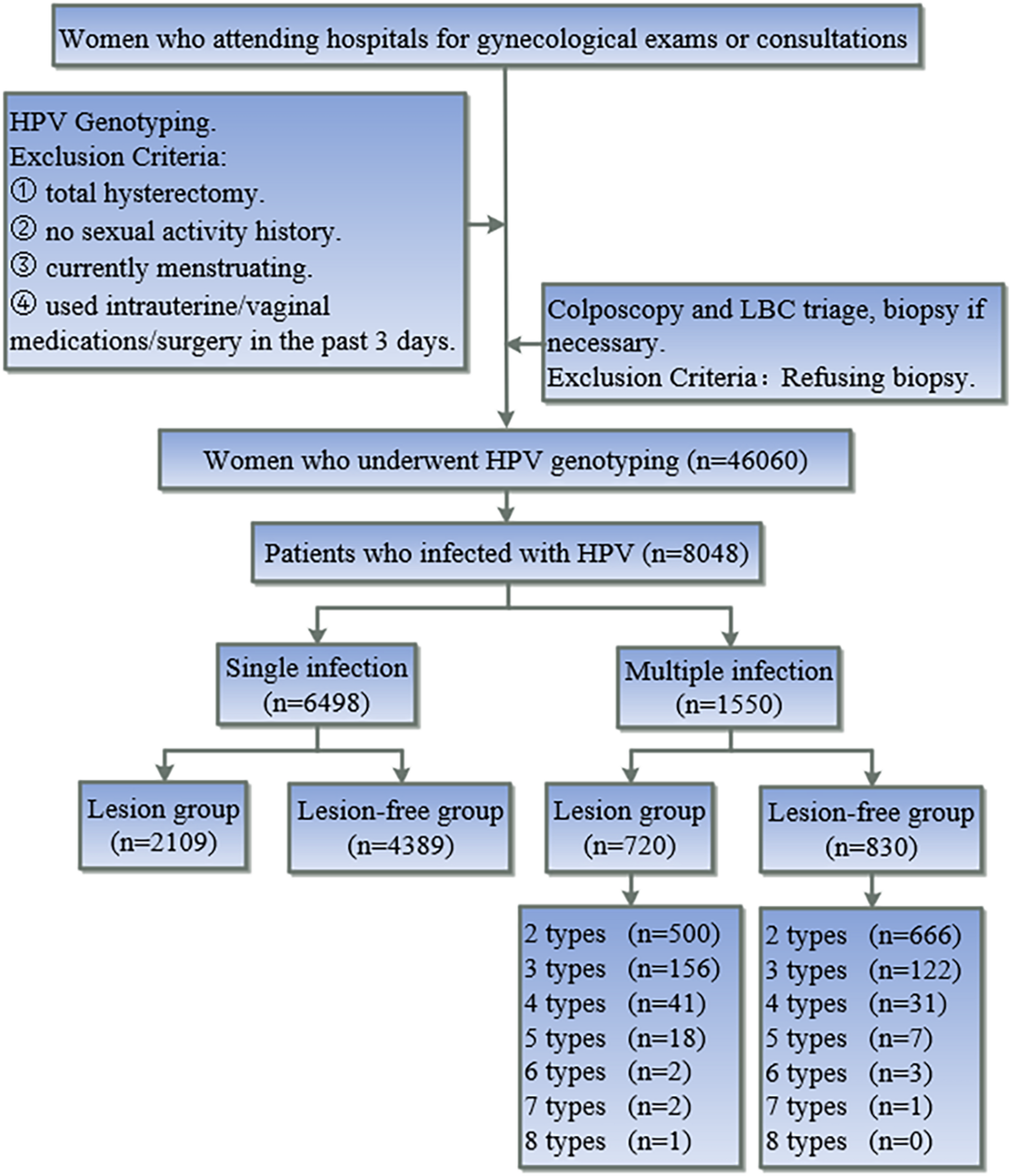Given the conflicting results regarding the pathogenicity of single and multiple HPV infections, this study analyzed the differences in the ability of single and multiple infections to cause cervical lesions (CIN and cervical cancer) using a large sample size. Similar to previous studies, we compared single and multiple infections by contrasting the non-lesion and lesion groups [6, 8] and found that multiple infections had a stronger ability to cause cervical lesions than single infections. In contrast to other studies, we further subdivided the number of HPV infections into eight types and analyzed the proportion of lesions in relation to infection multiplicity. We found that a higher multiplicity of infections was associated with a higher proportion of cervical lesions.
The distribution of HPV types varies significantly across countries and regions. The development of diagnostic and preventive strategies should be based on the prevalence of HPV, with high prevalence and pathogenicity being the focus of detection and prevention [15]. Numerous studies have specifically reported the regional characteristics of HPV distribution, demonstrating that the distribution of HPV types has significant geographical differences. The five most common high-risk types in our study were HPV52, 58, 16, 53, and 51, which differed substantially from those found in studies conducted in Italy (HPV16, 31, 66, 56, 51) [16], Iran (HPV16, 56, 53, 59, 52) [17]; and Ethiopia (HPV 16, 52, 35, 18, 56) [18]. There were minor differences compared to other regions in China, such as Beijing (HPV52, 58, 16, 51, 66) [19], Shanghai (HPV52, 58, 16, 68, 51) [20], and Suzhou (HPV52, 58, 16, 68, 51) [21], where HPV52 was the most prevalent type. Among all carcinogenic HPVs, HPV16 and 18 are considered the two high-risk types with the strongest pathogenicity, followed by HPV31, 33, 45, 52, and 58; HPV39, 51, 53, 56, and 59 belong to high-risk types with lower risk levels [22, 23]. HPV73, 26, and 82 have weaker pathogenicity and require more clinical data to confirm their carcinogenic potential [22, 23]. Our results generally supported the pathogenicity ranking. Many studies in China have found that HPV52 is the most common high-risk type and is most prevalent in the lesion group [19]. Although HPV52 was the most common high-risk type in the lesion group, HPV16 had the highest relative risk of distribution in the lesion group. In terms of pathogenicity, HPV16 remains stronger than HPV52 [19].
In our study, the distribution rankings of various HPV types in single and multiple infections were not significantly different from the overall infection/detection rate rankings. The most common types (HPV52, 58, and 16) were prevalent in both single and multiple infections. However, there are still differences in the relative risk of these types between multiple and single infections. The types of HPV associated with the lowest relative risk values for multiple infections were HPV52, 58, 16, and 18 (HPV52 and 58 were statistically significant, whereas HPV16 and 18 were not), suggesting that these four highly pathogenic types are more likely to occur in single infections. As the detection rate decreased, the relative risk values for these types of multiple infections gradually increased. Although one study described that HPV31, 51, and 52 were more commonly distributed in multiple infections [24], our results also indicated that rarer HPV types were more likely to be found in multiple infections. Similarly, data listed in a meta-analysis showed that as the positive rate of types decreased, the proportion of multiple infections decreased [25].
Our analysis focused on the difference in pathogenicity between single and multiple HPV infections. Owing to conflicting results, the impact of multiple infections on cervical cancer development requires further investigation. Specifically, the first perspective posits that mixed infections with multiple HPV types may lead to competition between genotypes, thereby reducing the likelihood of severe cervical lesions [26, 27]. Conversely, the second view argues that synergistic effects exist between different HPV genotypes, leading to more severe cervical lesions [28,29,30]. The risk of cervical cancer in cases of multiple infections is 31.8 times higher than that of single HPV infection [31]. Multiple HPV infections are a significant risk factor for CIN ≥ 2 [31]. These results suggest that multiple infections may more effectively evade the host immune response, thereby promoting persistent HPV infection. A third perspective contends that there is no significant difference in pathogenicity between multiple and single infections, with lesion severity solely related to the HPV type rather than the number of infections [32, 33], implying that competitive or synergistic effects may not exist between HPV types in mixed infections. Our findings showed that the odds ratio of the lesion group with multiple infections was significantly higher than that with single infections, indicating a stronger pathogenicity of multiple infections. More importantly, a correlation analysis between the number of infections and the proportion of the lesion group revealed that a higher HPV infection multiplicity was associated with a higher intragroup lesion rate, suggesting that increased infection burden correlates with stronger pathogenicity, further validating the enhanced pathogenic potential of multiple infections. HPV16 was the primary driver of cervical lesions, followed by HPV18, and then 31, 33, 45, 52, and 58. Our results also showed that HPV52, 58, 16, and 18 were relatively less likely to be distributed in multiple infections compared to the other types. Because these are common and highly pathogenic, this excludes the possibility that the stronger pathogenicity of multiple infections is due to the enrichment of high-pathogenicity types in multiple infections.
Limitations of the Study: One limitation is that we subdivided HPV infections into 8 multiple infections. To ensure a sufficient sample size for each infection level, we did not further differentiate the lesion groups (e.g., between different grades of CIN or cervical cancer). Additionally, the study was conducted at a single center.
